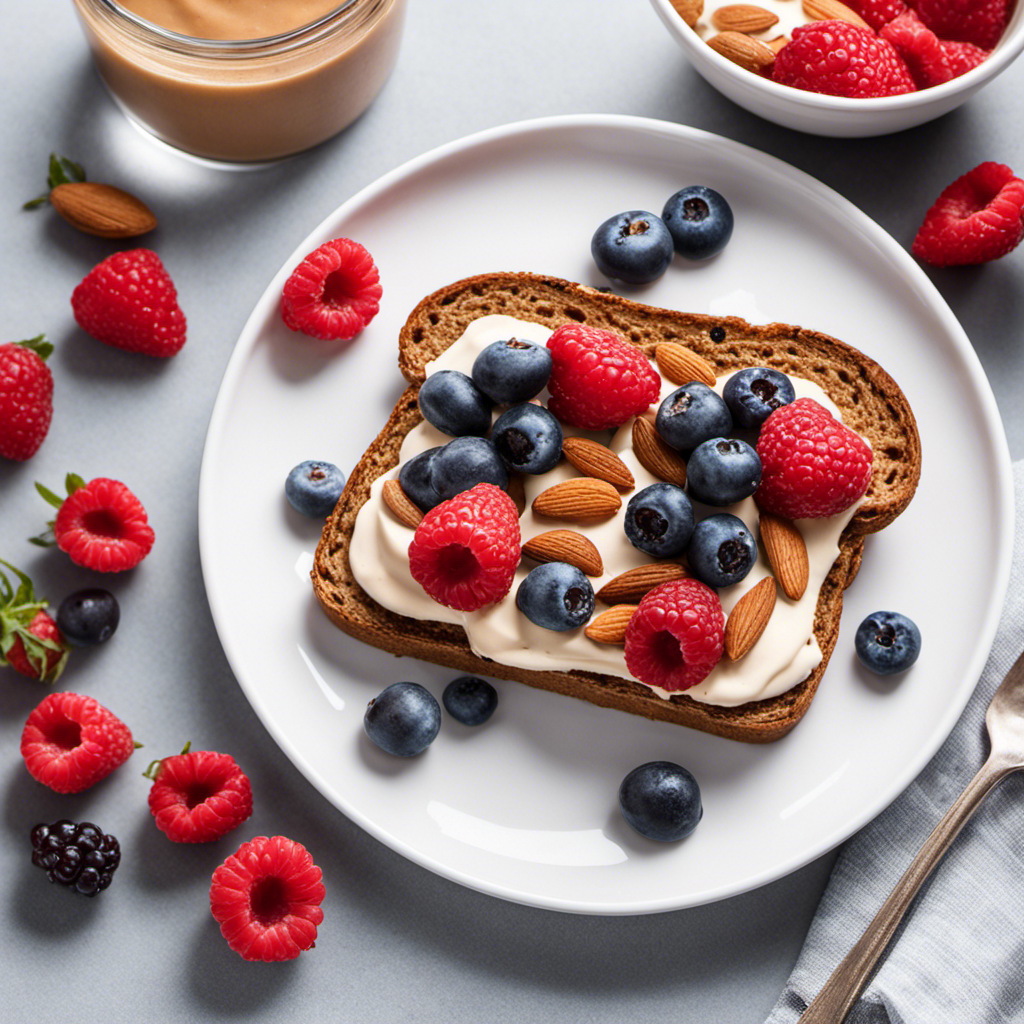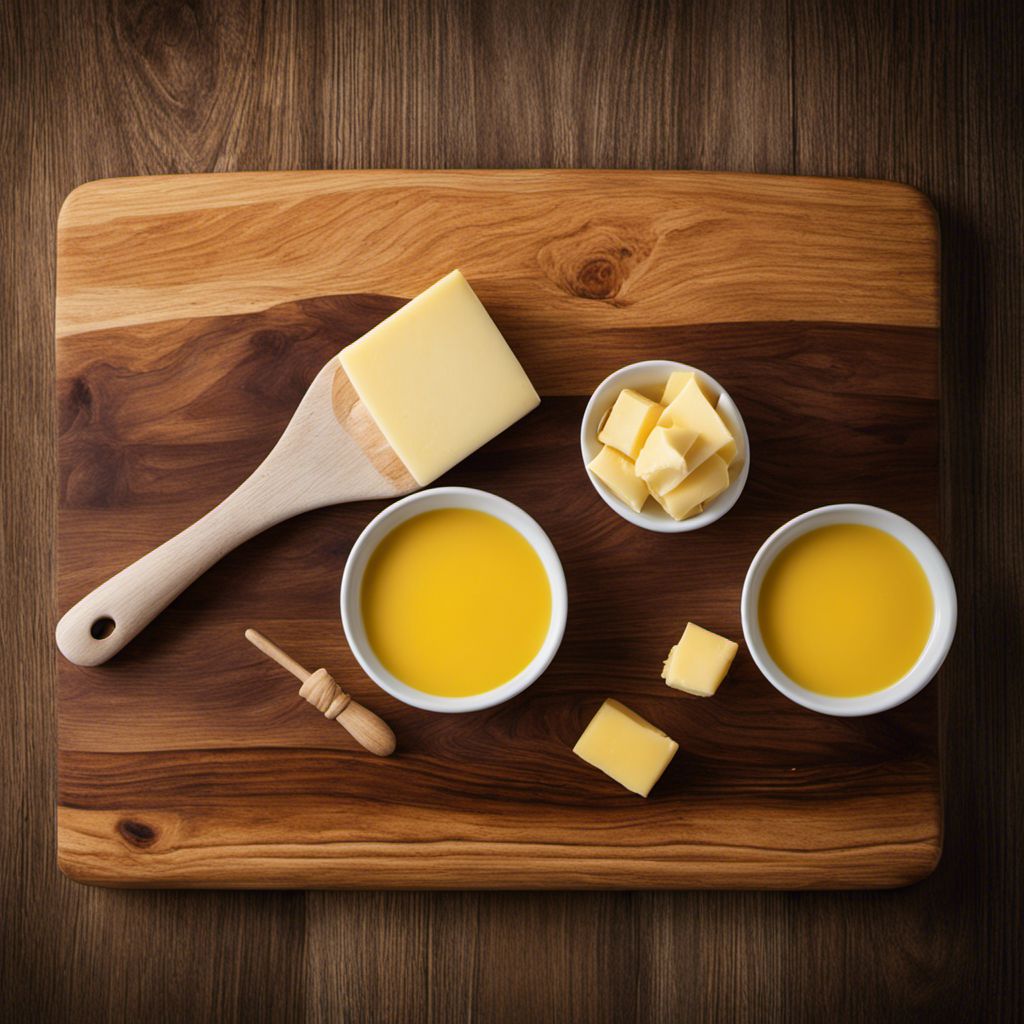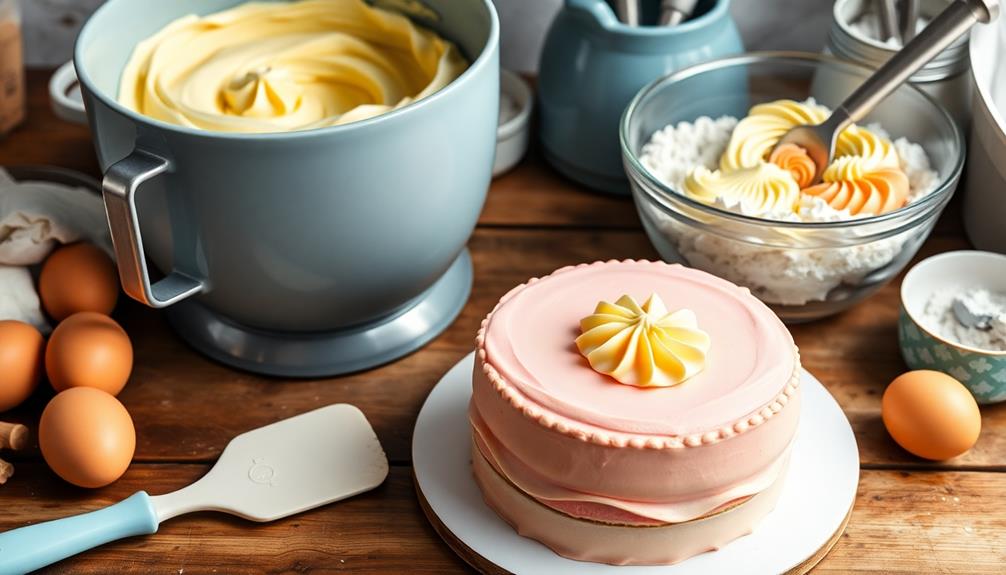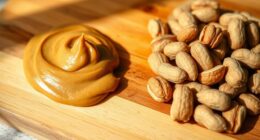As someone who greatly appreciates both popcorn and everything with a buttery flavor, I frequently catch myself contemplating the timeless inquiry: in an automatic popcorn maker, where should the butter be placed?
Well, fear not, fellow popcorn connoisseurs, for in this article, we will unravel the mysteries of butter placement in the beloved Nostalgia Popcorn Maker.
With a dash of knowledge, a sprinkle of objectivity, and a dollop of detail, we will explore the ins and outs of melting butter, distributing it evenly, and keeping our popcorn experience as buttery as can be.
So, let’s dive in and discover the buttery secrets of this marvelous machine!
Key Takeaways
- The butter goes in the designated compartment of the automatic popcorn maker.
- Troubleshooting steps for the butter dispenser include checking for clogs or blockages, cleaning the dispenser, and ensuring the butter is not too cold or hard.
- Flavored butter can enhance the taste of popcorn and be a healthier alternative to traditional butter.
- Experiment with different techniques to find the perfect consistency for the popcorn and achieve even distribution of the melted butter.
Understanding the Automatic Popcorn Maker
The butter goes in the designated compartment of the automatic popcorn maker. This compartment is specifically designed to melt the butter while the popcorn is popping, ensuring that it is evenly distributed over the popcorn.
There are several techniques to melt the butter effectively in the automatic popcorn maker. One common method is to place the butter in the compartment and turn on the popcorn maker. As the popcorn pops, the heat generated by the machine melts the butter, allowing it to drip onto the popcorn.
Another technique is to melt the butter beforehand and then pour it into the compartment. This ensures that the butter is already in a liquid state and will spread evenly over the popcorn.
However, if you experience any issues with the butter dispenser, there are troubleshooting steps you can take. First, check that the dispenser is clean and free of any clogs or blockages. If necessary, disassemble the dispenser and clean it thoroughly. Additionally, make sure that the butter is not too cold or too hard, as this can cause it to clog the dispenser.
Exploring the Features of the Nostalgia Popcorn Maker
One of the features I love about the Nostalgia popcorn maker is how easy it is to use. Not only does it make delicious popcorn, but it also offers some great options for exploring butter alternatives.
While traditional butter is a popular choice, flavored butter can take your popcorn to the next level. The Nostalgia popcorn maker allows you to experiment with different flavors and create a unique popcorn experience.
Using flavored butter has several benefits. Firstly, it adds a burst of flavor to your popcorn, enhancing the overall taste. Whether you prefer savory flavors like garlic or cheese, or sweet flavors like caramel or cinnamon, the Nostalgia popcorn maker allows you to easily incorporate these flavors into your popcorn.
Secondly, flavored butter can be a healthier alternative to traditional butter. By using herbs, spices, or natural extracts, you can create delicious flavors without adding excessive calories or unhealthy additives.
To use flavored butter in the Nostalgia popcorn maker, simply melt the desired amount of butter in a microwave-safe dish. Once melted, add your preferred flavorings and mix well. Then, pour the flavored butter over the freshly popped popcorn and toss it gently to ensure even distribution.
The result is a tasty and customizable popcorn experience that will satisfy your cravings. So why not explore the world of butter alternatives and elevate your popcorn game with the Nostalgia popcorn maker?
The Importance of Adding Butter to Your Popcorn
When it comes to elevating your popcorn experience, adding butter is an essential step. Butter adds richness and flavor to the popcorn, making it more enjoyable and delicious.
However, if you are looking for butter alternatives, there are a few options you can consider.
One popular alternative is ghee, which is a clarified butter that has been used in Indian cuisine for centuries. Ghee has a rich, nutty flavor and can be a healthier choice compared to regular butter.
Another option is coconut oil, which adds a unique tropical taste to the popcorn. Coconut oil is also known for its health benefits, as it contains medium-chain triglycerides that can boost metabolism and improve brain function.
Lastly, you can try using olive oil, which is a heart-healthy option. Olive oil is rich in monounsaturated fats, which can help lower cholesterol levels and reduce the risk of heart disease.
Butter Placement in an Automatic Popcorn Maker
To ensure optimal butter distribution in your automatic popcorn maker, simply melt the butter in a separate container before adding it to the machine. This technique allows the butter to evenly coat the popcorn, resulting in a more flavorful and satisfying snack.
There are various butter melting techniques you can try to achieve the perfect consistency for your popcorn. One popular method is to melt the butter in a microwave-safe bowl by heating it in short intervals and stirring in between. Another option is to melt the butter on the stovetop using a double boiler or a small saucepan over low heat. Once the butter is melted, you can then drizzle it over the popcorn in the popcorn maker.
- Melt the butter in a separate container before adding it to the popcorn maker.
- Use the microwave or stovetop to melt the butter.
- Ensure the butter is evenly distributed by drizzling it over the popcorn.
Alternative butter placement methods can also be explored. Some popcorn makers have a built-in butter melting tray where you can place a few small pats of butter. As the popcorn pops, the heat from the machine melts the butter and evenly distributes it throughout the popcorn. Another option is to use a butter sprayer or flavoring oil to add a burst of buttery flavor to your popcorn. These methods offer convenience and can be a great alternative if you don’t want to melt butter separately.
Overall, the key is to experiment with different techniques until you find the one that suits your taste preferences and gives you the perfect buttery popcorn experience.
Tips for Melting Butter in the Popcorn Maker
If using a microwave, simply place the butter in a microwave-safe bowl and heat it in short intervals, stirring in between, until melted. This is one of the most common and convenient butter melting techniques that can be used for making popcorn. However, if you don’t have access to a microwave or prefer to melt the butter directly in the popcorn maker, there are other techniques you can try.
When it comes to butter distribution techniques, it’s important to ensure that the butter is evenly spread throughout the popcorn. This can be achieved by using a popcorn maker with a built-in butter melting tray or by adding melted butter directly to the popcorn kernels before they are popped. Here are some tips for achieving the perfect butter distribution:
-
Use a popcorn maker with a built-in butter melting tray: This type of popcorn maker allows the butter to melt and drip directly onto the popcorn as it pops, ensuring even distribution.
-
Add melted butter to the popcorn kernels: Before adding the popcorn kernels to the popcorn maker, melt the butter and drizzle it over the kernels. Mix well to ensure that every kernel is coated with butter.
-
Stir the popcorn: After the popcorn is done popping, give it a good stir to distribute the melted butter evenly.
Adding Butter to the Popcorn Kernels
Now that we’ve discussed the melting process of butter in the popcorn maker, let’s move on to the next step: adding the butter to the popcorn kernels. This is an essential step in achieving optimal flavor for your popcorn.
When it comes to adding butter to the popcorn kernels, there are a few key points to keep in mind:
-
Timing: It’s important to add the melted butter to the popcorn at the right moment. Waiting too long may result in the butter solidifying and not evenly coating the kernels. On the other hand, adding it too early can make the popcorn soggy. Aim to add the butter just as the popcorn finishes popping.
-
Even distribution: To ensure every kernel gets a delicious buttery coating, it’s crucial to distribute the melted butter evenly. One way to do this is by drizzling the butter over the popcorn while gently shaking the popcorn maker or stirring the popcorn with a wooden spoon.
-
Tossing: After adding the butter, give the popcorn a good toss to ensure all the kernels are evenly coated. This will help to distribute the flavor and prevent any clumps of butter from forming.
Finding the Butter Dispenser in the Nostalgia Popcorn Maker
When it comes to using the Nostalgia Popcorn Maker, one of the key points to consider is the location of the butter dispenser. Knowing where to find it is crucial for a smooth and efficient popcorn-making process.
Additionally, understanding the butter melting process is essential for achieving that perfect buttery flavor. By discussing these two aspects, we can ensure a delightful popcorn experience every time.
Butter Dispenser Location
To put the butter in the automatic popcorn maker, you’ll find the dispenser located on the top of the machine. This convenient placement allows for easy access and ensures that the butter is evenly distributed throughout the popcorn.
When it comes to measuring the butter, it is important to follow the instructions provided by the manufacturer. Some popcorn makers have a specific butter measurement that should be used to achieve the best results. However, if you prefer alternative butter options, such as flavored oils or margarine, it is essential to check the user manual for compatibility.
Using the correct butter measurement and exploring alternative options can enhance the flavor and enjoyment of your popcorn, making movie nights even more delicious.
- Check the user manual for the recommended butter measurement.
- Consider using flavored oils for a unique popcorn experience.
- Explore alternative butter options, such as margarine, if desired.
Butter Melting Process
For smooth and melted butter, simply place a few tablespoons into a microwave-safe bowl and heat in short intervals, stirring in between, until it reaches a liquid consistency. This method ensures that the butter is evenly melted and ready to be used.
It is important to note that the temperature of the butter plays a crucial role in achieving the desired result. Room temperature butter is ideal for melting as it melts quickly and evenly. If you don’t have room temperature butter, you can also use alternative options like ghee or clarified butter, which melt easily due to their higher fat content.
Once the butter is melted, it can be poured or drizzled over your popcorn, adding a delicious and indulgent flavor.
Now that we have our melted butter ready, let’s move on to the next step in our step-by-step guide to butter placement.
Step-by-Step Guide to Butter Placement
First, you’ll want to locate the butter compartment in your Nostalgia popcorn maker. This is an essential step in ensuring that your popcorn has that perfect buttery flavor.
To help you achieve the best results, here are some tips for melting butter and avoiding common mistakes:
- Use unsalted butter: Salted butter can make your popcorn taste overly salty, so it’s best to stick with unsalted butter for a balanced flavor.
- Melt the butter separately: It’s important to melt the butter before adding it to the popcorn maker. This allows for better distribution and ensures that every kernel gets coated evenly.
- Be mindful of the temperature: Avoid overheating the butter, as it can lead to a burnt taste. Melt it slowly over low heat or in short bursts in the microwave, stirring occasionally.
By following these tips, you’ll be on your way to enjoying delicious buttery popcorn.
Now let’s move on to the next section and discuss the optimal placement of butter for the best popcorn flavor.
Butter Placement for Optimal Popcorn Flavor
Now let’s focus on where you should place the butter to achieve the optimal flavor for your popcorn. When it comes to butter placement, it’s important to consider the temperature of the butter and how it affects the flavor of your popcorn. The temperature at which you add the butter can greatly impact the taste and overall experience of your popcorn. To help you understand the different flavor variations that can be achieved, let’s take a look at the table below:
| Butter Temperature | Flavor Variation |
|---|---|
| Cold | Less intense, subtle butter flavor |
| Room Temperature | Balanced butter flavor |
| Melted | Rich, buttery taste |
By placing cold butter on your popcorn, you’ll get a more subtle butter flavor that doesn’t overpower the popcorn. Room temperature butter provides a balanced butter flavor that is neither too subtle nor too overpowering. If you prefer a rich and buttery taste, melting the butter before adding it to your popcorn is the way to go. The melted butter will coat the popcorn evenly, ensuring each bite is packed with buttery goodness.
Common Mistakes When Adding Butter to the Popcorn Maker
One common mistake when adding butter to the popcorn maker is not considering the optimal temperature for the butter. It is crucial to melt the butter properly before adding it to the popcorn maker to ensure an even distribution and enhance the flavor of the popcorn.
To avoid this mistake, there are several butter melting techniques you can try:
-
Use a microwave-safe bowl: Place the desired amount of butter in a microwave-safe bowl and heat it in short bursts, stirring in between, until it is completely melted.
-
Utilize a stovetop method: In a small saucepan, melt the butter over low heat, stirring constantly to prevent it from burning. Once melted, remove it from the heat and let it cool slightly before adding it to the popcorn maker.
-
Consider using a butter melter: Some popcorn makers come with a built-in butter melter, which saves you the hassle of melting the butter separately. Simply add the butter to the designated compartment, and it will melt as the popcorn pops.
When troubleshooting the butter dispenser, keep in mind that it may get clogged if the butter is not melted thoroughly or if it contains solid particles. To prevent this, ensure that the butter is completely melted and strain it before adding it to the dispenser. Additionally, clean the dispenser regularly to remove any residue that may accumulate and impede the flow of butter.
Enhancing the Taste With Butter in the Nostalgia Popcorn Maker
To enhance the taste of your popcorn in the Nostalgia Popcorn Maker, try experimenting with different types of melted butter. Butter is a classic and delicious addition to popcorn, and there are various techniques you can use to melt it and maximize its flavor.
| Butter Melting Techniques | Description |
|---|---|
| Stovetop Melting | Place butter in a small saucepan and melt over low heat. This method allows for better control over the melting process. |
| Microwave Melting | Cut the desired amount of butter into small pieces and place them in a microwave-safe bowl. Heat in short intervals, stirring in between, until fully melted. |
| Double Boiler Method | Fill a saucepan with water and bring it to a simmer. Place a heatproof bowl on top of the saucepan, making sure it doesn’t touch the water. Add the butter to the bowl and stir until melted. |
In addition to enhancing the taste, using butter in popcorn also offers health benefits. Butter contains essential vitamins and minerals, such as vitamin A, D, E, and K. It also provides healthy fats that are necessary for the body. However, it’s important to consume butter in moderation due to its high calorie and fat content.
Now that you know how to melt butter and the health benefits it can provide, let’s move on to the next section and discuss the safety precautions for placing butter in the automatic popcorn maker.
Safety Precautions for Butter Placement in the Automatic Popcorn Maker
When using the automatic popcorn maker, make sure to exercise caution when adding butter to prevent any potential accidents. Butter can enhance the taste of popcorn, but it can also cause splattering and create a mess if not added properly.
To ensure a safe and enjoyable popcorn-making experience, follow these guidelines:
-
Place the butter in a microwave-safe bowl: Before adding the butter to the popcorn maker, melt it in a separate bowl using your preferred butter melting technique. This can be done in the microwave or on the stovetop. By melting the butter beforehand, you can control the consistency and prevent any splattering.
-
Add the melted butter gradually: Once the butter is melted, slowly pour it over the popcorn kernels in the popcorn maker. Avoid dumping the entire amount at once, as this can result in uneven distribution and potential splatter. Instead, pour it in a circular motion to evenly coat the popcorn.
-
Stir the popcorn: After adding the melted butter, use a wooden spoon or a popcorn paddle to gently stir the popcorn. This will help distribute the butter evenly and prevent any clumps from forming.
Butter Distribution Techniques for Evenly Flavored Popcorn
When it comes to achieving the perfect buttery flavor on popcorn, the application method plays a crucial role. In this discussion, I will delve into the best butter application method that ensures even distribution and maximum flavor absorption.
Additionally, I will share some homemade flavored butter recipes that will take your popcorn experience to the next level.
Best Butter Application Method
The best way to apply butter in an automatic popcorn maker is by melting it first. This ensures that the butter is evenly distributed and coats every kernel of popcorn. When using melted butter, it is important to consider the temperature. The butter should be melted but not too hot, as it can cause the popcorn to become soggy. A temperature of around 120°F (49°C) is ideal for butter application.
If you prefer not to use butter, there are alternatives that can still enhance the flavor of your popcorn. Some popular butter alternatives include:
-
Coconut oil: This oil has a rich, buttery flavor that pairs well with popcorn. It also has a high smoke point, making it perfect for use in popcorn makers.
-
Olive oil: This oil adds a subtle, fruity flavor to popcorn. It is a healthier alternative to butter and can be drizzled over the popcorn for a light coating.
-
Flavored oils: There are a variety of flavored oils available, such as truffle oil or chili oil, that can add a unique and delicious twist to your popcorn.
Remember to experiment with different butter alternatives and find the one that suits your taste preferences the best.
Homemade Flavored Butter Recipes
When it comes to making popcorn, using flavored butter alternatives can take your snacking experience to the next level. Flavored butter adds a burst of deliciousness to your popcorn, making it a tasty treat that you won’t be able to resist.
There are numerous benefits to using flavored butter. Firstly, it allows you to customize your popcorn with different flavors, such as garlic, herb, or even sweet options like caramel or chocolate. This variety ensures that there is always something to satisfy your cravings.
Secondly, flavored butter can enhance the overall taste and aroma of the popcorn, making it more enjoyable.
Lastly, using flavored butter alternatives can be a healthier option compared to traditional butter, as you can control the ingredients and reduce the amount of fat and calories.
With these benefits in mind, let’s move on to the next section and explore the exciting world of experimenting with different butter amounts in the popcorn maker.
Experimenting With Different Butter Amounts in the Popcorn Maker
You can’t go wrong with a little extra butter in your popcorn maker. Adding butter to your popcorn not only enhances the flavor but also adds a delicious richness to each bite. However, it’s important to find the right balance of butter to avoid making the popcorn too greasy.
Here are some tips for measuring butter and experimenting with flavored butter in your popcorn maker:
-
Start with a small amount: Begin by adding a tablespoon or two of melted butter to your popcorn. This will give you a good starting point to gauge the desired level of butteriness.
-
Gradually increase the amount: If you feel like the popcorn needs more butter, add another tablespoon or two and mix well. Keep tasting and adjusting until you reach your preferred level of buttery goodness.
-
Try flavored butter: Experiment with different flavors by using homemade flavored butter. Mix in some garlic butter, truffle butter, or even chili lime butter for a unique and tasty twist.
Cleaning and Maintenance Tips for the Butter Dispenser
To keep the butter dispenser clean and functioning properly, it’s essential to regularly remove any leftover butter residue and wipe it down with a soft cloth. Cleaning the butter dispenser not only ensures its longevity but also prevents clogs that can impede the smooth flow of butter onto your popcorn.
First, unplug the popcorn maker and allow it to cool down. Once it’s safe to handle, remove the butter dispenser from the machine. Check for any remaining butter residue inside the dispenser and scrape it off using a plastic spatula or spoon. Be careful not to use any sharp objects that could scratch the surface.
Next, fill a sink or basin with warm water and a mild dish soap. Submerge the butter dispenser in the soapy water and let it soak for a few minutes. Then, using a soft cloth or sponge, gently scrub the inside and outside of the dispenser to remove any stubborn butter residue. Rinse thoroughly with clean water and dry it completely before reattaching it to the popcorn maker.
Regular cleaning of the butter dispenser is crucial to prevent clogs. If you notice any butter buildup or clogging, use a small brush or toothpick to remove it. Additionally, make sure to wipe down the dispenser after each use to remove any excess butter that may have splattered.
Frequently Asked Questions
Can I Use Any Type of Butter in an Automatic Popcorn Maker?
Sure, you can use any type of butter in an automatic popcorn maker. To properly melt the butter, place it in the designated butter melting tray or follow the instructions provided by the manufacturer.
Will Adding Butter to the Popcorn Maker Affect the Overall Cooking Time?
Adding butter to the popcorn maker can affect the overall cooking time. It’s important to follow the manufacturer’s instructions on butter dispersion methods for optimal results. The butter adds richness and enhances the taste and texture of the popcorn.
Can I Add Other Flavorings or Oils to the Butter in the Popcorn Maker?
Yes, you can add other flavorings or oils to the butter in the popcorn maker. This will enhance the taste of your popcorn and give you a variety of options for flavored popcorn.
How Do I Clean the Butter Dispenser in the Nostalgia Popcorn Maker?
When it comes to cleaning the butter dispenser in the Nostalgia popcorn maker, I’ve got it covered. The process is simple and straightforward, ensuring that your machine stays in tip-top shape. Plus, there are alternative butter options to explore!
Are There Any Safety Precautions I Need to Take When Adding Butter to the Popcorn Maker?
When adding butter to an automatic popcorn maker, it is important to follow the manufacturer’s instructions and safety precautions. Adding butter can enhance flavor, but it may also affect the texture of the popcorn.
Conclusion
In conclusion, placing butter in an automatic popcorn maker is a crucial step to achieving delicious and flavorful popcorn. By following proper butter placement techniques and using the built-in butter dispenser, you can ensure that each kernel is coated evenly.
Did you know that according to a survey conducted by the Popcorn Board, 64% of Americans prefer their popcorn with butter? This statistic highlights the widespread love for buttery popcorn and the importance of mastering the butter placement in your automatic popcorn maker.
So go ahead, indulge in the buttery goodness and enjoy your perfectly popped popcorn!










